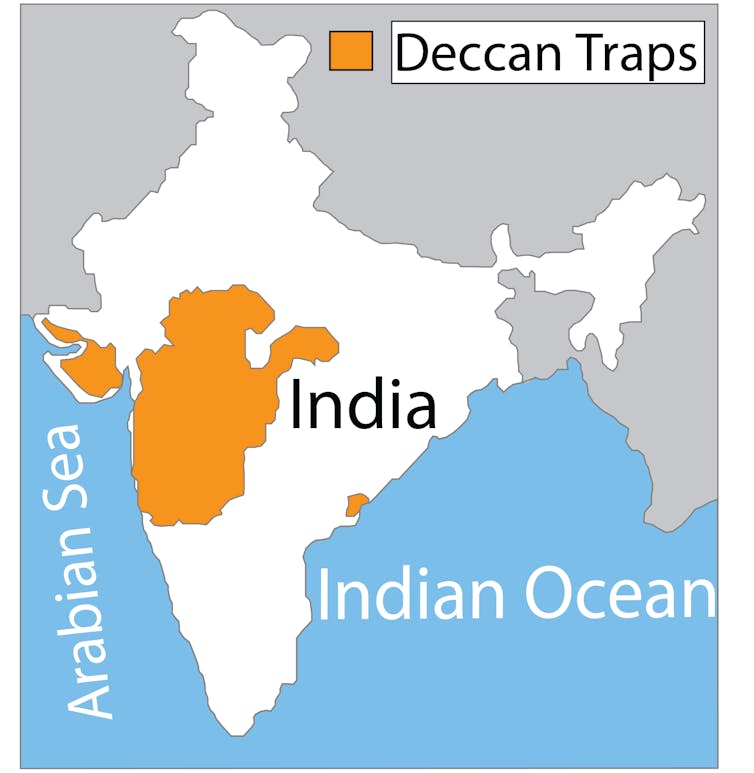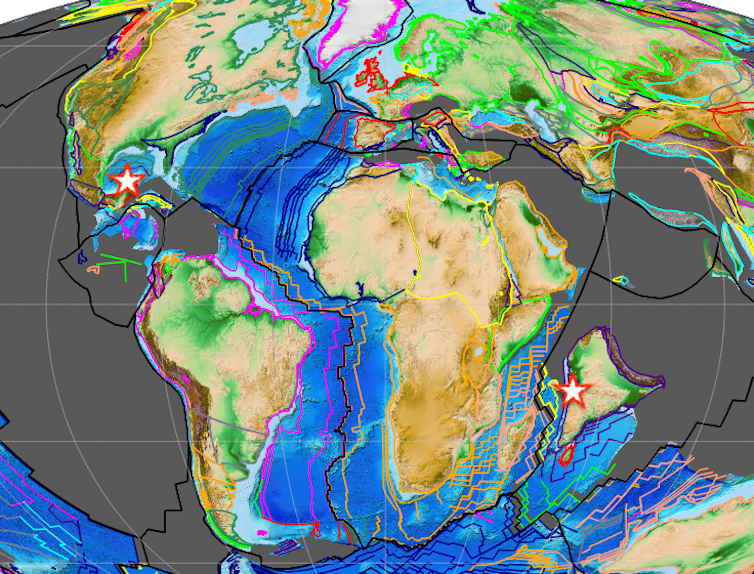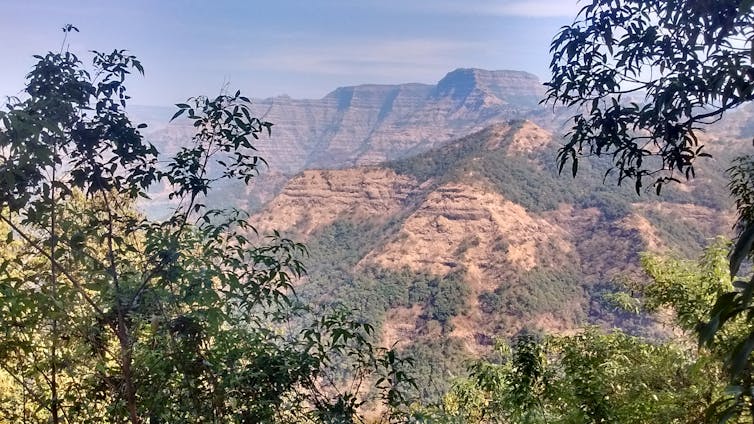asteroid collision triggered potentially deadly volcanic eruptions
- Written by Craig O'Neill, Director of the Macquarie Planetary Research Centre/Associate Professor in Geodynamics, Macquarie University
It’s almost 40 years since scientists discovered what wiped out the dinosaurs: an asteroid hitting Earth near modern-day Mexico. That was it, or so we thought.
A paper published today in Science further supports an alternative hypothesis: that catastrophic events following the impact could have helped cause the end of the dinosaurs and many other forms of life.
This builds on earlier work – including some published last year – suggesting a connection between the asteroid impact, increased volcanic eruptions, and the mass extinction event.
Sudden impact
Back in 1980, the American experimental physicist Luis Alvarez, his geologist son Walter and their colleagues published an influential paper in the journal Science.
Read more: Life quickly finds a way: the surprisingly swift end to evolution's big bang
In it, they outlined evidence of a global catastrophe, buried in a layer spread all over the planet, about 66 million years ago.
They found high levels of iridium – a rare element in Earth’s crust, but common in meteorites. They found shocked quartz – grains of quartz with telltale fractures from the blast wave of the impact, as well as evidence of molten rock thrown out from the impact blast.
With the later discovery of the Chicxulub impact crater on the Yucatan Peninsula, Mexico, the case seemed sealed.
The reign of the dinosaurs ended with a meteorite impact, marking the end of the Cretaceous, and start of the Paleogene period, called the K-Pg boundary.
Was there something else?
Yet within the Earth science community, discontent continued to simmer.
Two of the largest mass extinctions in the geological record both coincide with the largest exposed continental flood basalt events in the past 542 million years. They are the end of the Permian 251 million years ago, and – as today’s Science paper highlights – the dinosaur extinction at the end of the Cretaceous 66 million years ago.
The coincidence seems too great.
In understanding the link between flood volcanism, meteorite impacts and extinctions, timing is everything.
In the new Science paper, a team from the United States and India present some of the most precise dates yet for the enormous eruptions in India, in a unit known as the Deccan Traps - an enormous flood basalt province in Western India that covers more than 500,000km2 and in places is more than 2km thick.
 Map outlining exposed areas of the Deccan Traps in modern day India.
Courtney Sprain
Map outlining exposed areas of the Deccan Traps in modern day India.
Courtney Sprain
They found that the best date for the Chicxulub impact – at 66.052 million years ago – was within 50,000 years of the peak eruption period of the Deccan Traps, meaning that the impact, and the ramp-up in volcanism, were essentially simultaneous.
A seismic connection
A connection between an impact in the Caribbean and volcanism in the Indian Ocean may seem tenuous, but in planetary science these associations are not uncommon.
One dramatic example is the Caloris Basin on the planet Mercury – a 1,500km-wide structure from an earlier meteorite impact.
Antipodal (at the opposite side of the planet) to this is a bizarre, fractured landscape called the disrupted terrain, which formed from shock waves from the impact at Caloris.
This forms a precedent of sorts - an impact can create geological changes at vast distances. But back on Earth 66 million years ago, Chicxulub and the Deccan Traps weren’t quite antipodal.
The Deccan Traps formed when that part of what is now India was roughly over present-day Reunion Island, a small French Island near Madagascar. This island is still volcanically active, and powered by the same mantle upwelling that caused the Deccan volcanism.
The Yucatan Peninsula, like much of the Americas, was significantly closer to Europe (see below).
 Reconstruction of Earth’s plates at 66 million years ago. The stars show the position of the Deccan Traps near India, and Chicxulub impact in Mexico.
Image created by C O'Neill using GPlates (Gplates.org), Author provided
Reconstruction of Earth’s plates at 66 million years ago. The stars show the position of the Deccan Traps near India, and Chicxulub impact in Mexico.
Image created by C O'Neill using GPlates (Gplates.org), Author provided
But that may not matter. It has long been argued, since at least Charles Darwin in 1840, that earthquakes may trigger eruptions.
The mechanisms are not well understood. Suggestions range from bubble formation in magmas, to the development of fractures in the crust allowing magma to escape faster.
It has been recognised, though, that despite their distance from earthquakes, some volcanoes are simply more sensitive to earthquake activity than others, particularly very active volcanoes. Few volcanic events were more active than the Deccan Traps.
 Deccan Traps lava flows in Western Ghats, India.
Courtney Sprain
Deccan Traps lava flows in Western Ghats, India.
Courtney Sprain
Increased volcanic activity
At the same time as the Deccan volcanic ramp-up, the global mid-ocean ridge system in the Pacific and Indian Oceans seems to have experienced increased activity.
Formed when two plates move apart, ocean ridges form the most extensive volcanic system on the planet.
Analysis of global gravity has indicated anomalously thick crust at the K-Pg boundary, formed due to excess volcanic activity. This effect is only seen in the fastestspreading, and thus most volcanically active, systems in the Pacific and Indian Oceans.
Together, these observations suggest a global pulse of volcanic input at the time of the Cretaceous mass extinction, driven by the shock wave of the Chicxulub impact.
Wipeout
Exactly how this perfect storm of natural disasters – an asteroid collision and increased volcanic activity – drove the mass extinction of so much life on Earth is unclear at the moment.
As Science paper’s first author, Courtney Sprain, a former UC Berkeley doctoral student now at the University of Liverpool, UK, puts it:
Either the Deccan eruptions did not play a role - which we think unlikely - or a lot of climate-modifying gases were erupted during the lowest volume pulse of the eruptions.
Read more: Curious Kids: How many dinosaurs in total lived on Earth during all periods?
Volcanism can warm the Earth, due to eruption of greenhouse gases like methane and carbon-dioxide. It can, along with impacts, also cool the atmosphere by adding sulfur aerosols or dust, respectively.
Gases can also reach the atmosphere from magma stewing below the surface, even without eruptions.
It’s not precisely clear how all these combined to decimate terrestrial and marine ecosystems, but an accurate timeline of events is critical to unravelling these interactions.
Authors: Craig O'Neill, Director of the Macquarie Planetary Research Centre/Associate Professor in Geodynamics, Macquarie University



















